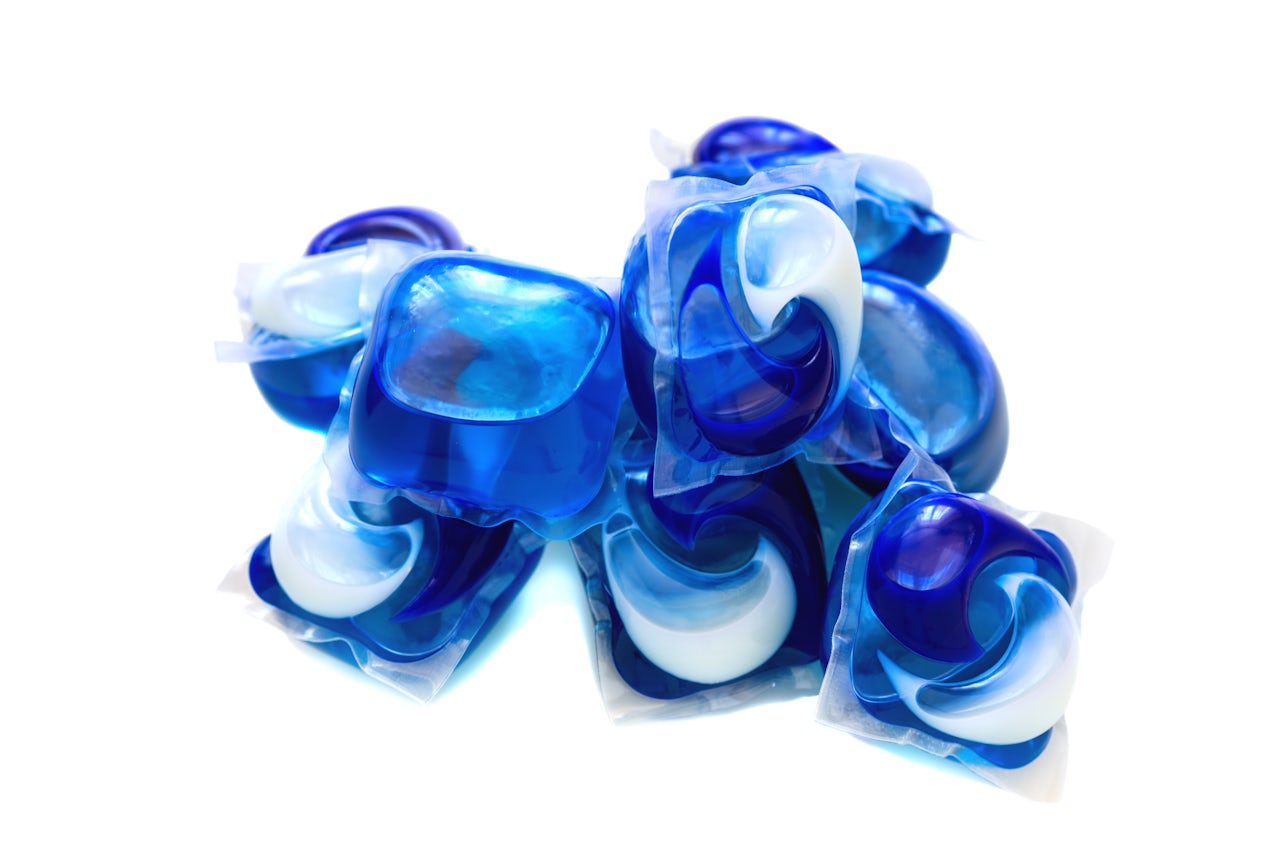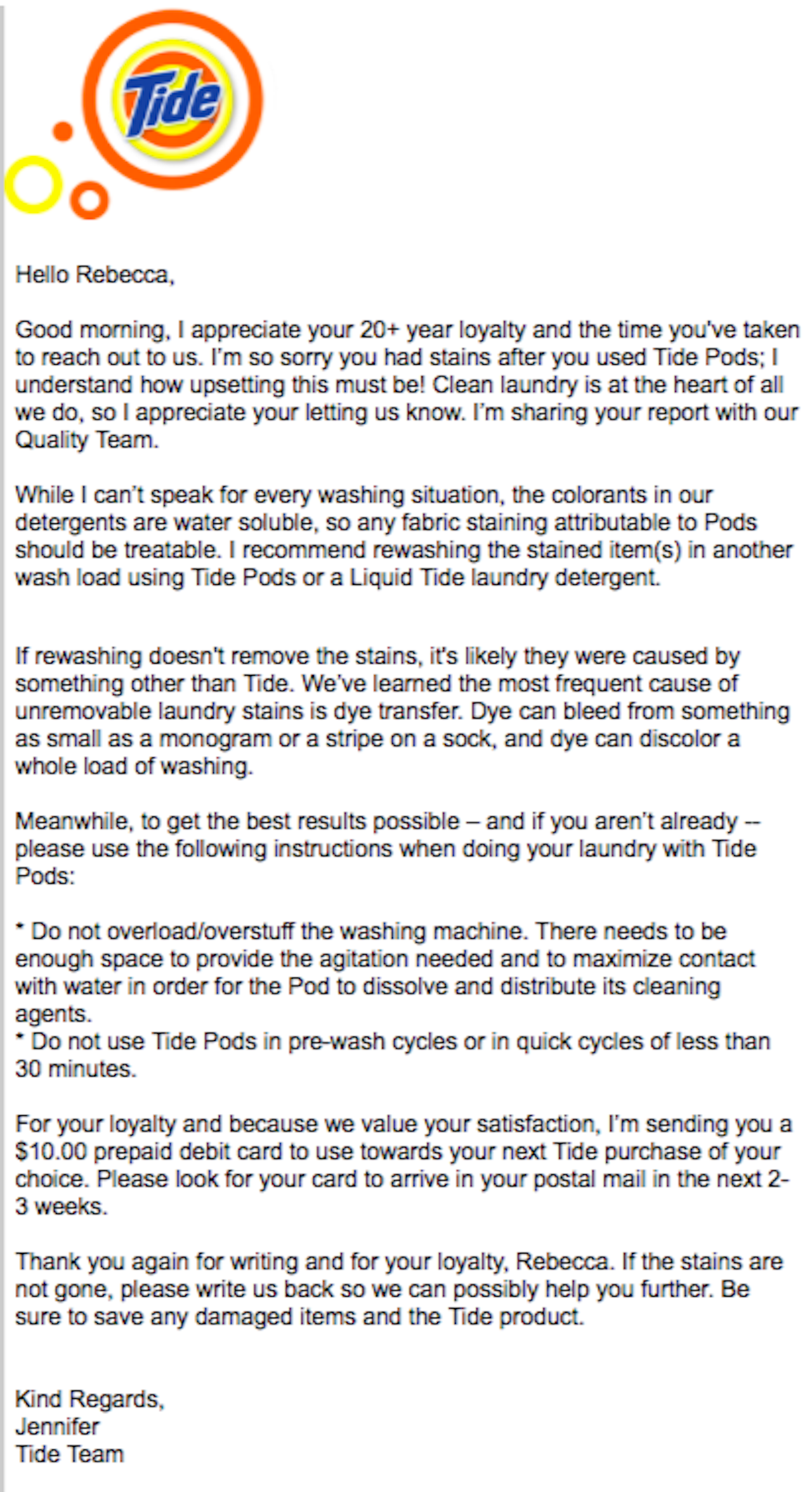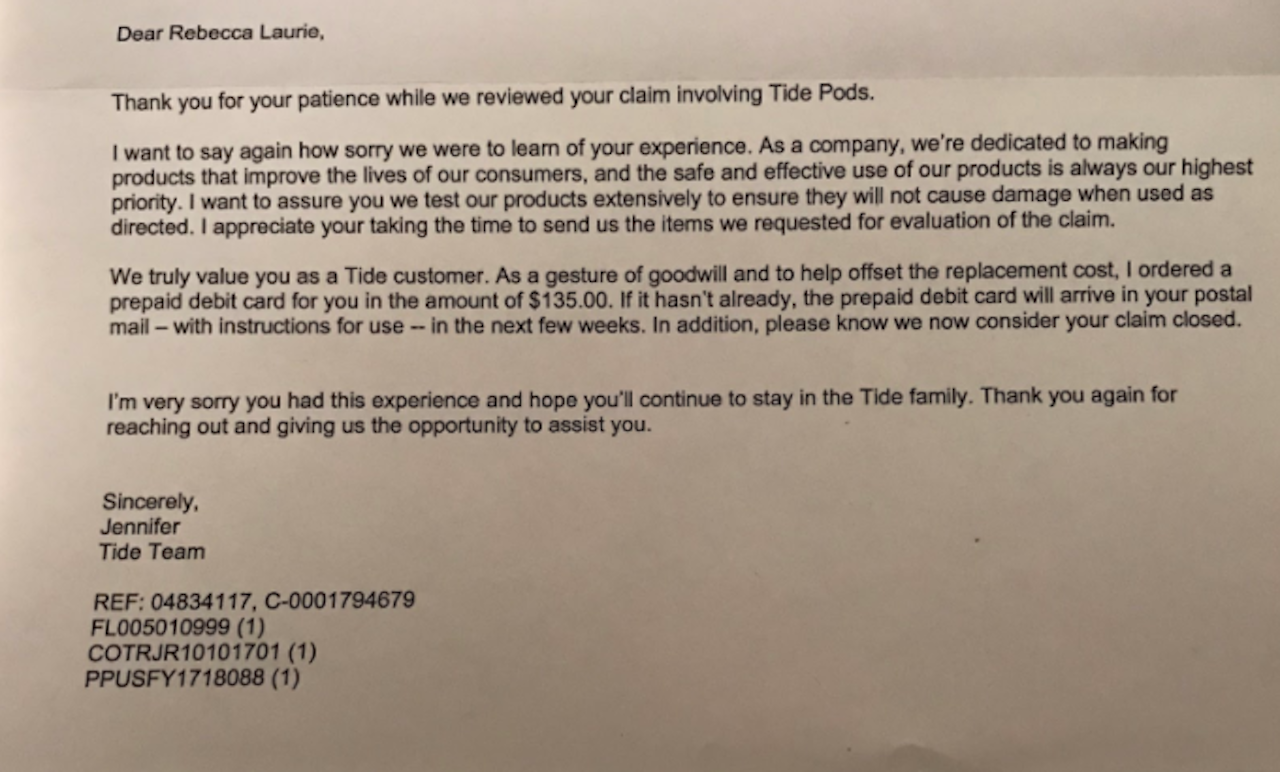A few months ago, indigo stains started mysteriously appearing on my clothes after I washed them. Not all of my clothes, and not all of the clothes in a given load of laundry; the stains were selective, appearing on mostly pink and red items. They were absolutely impossible to remove.
This saga started a little over a year ago, when my apartment building replaced the washers and dryers in its laundry room with shiny, new high-efficiency (HE) washers by Maytag. These machines are designed to use up to 80 percent less water and about half as much energy than traditional machines. My first few washes with the machines were a disaster. Since they use less water, the amount of suds in traditional laundry detergent can have an adverse impact on performance, causing the machine to inadequately rinse the soap residue off of the clothing. Despite my research and painstaking measurements, the loads emerged either still dirty or oversaturated with suds. There was either too much product or not enough.
So I gave in, reluctantly, to laundry pods. I became convinced that HE machines were a conspiracy designed to force consumers into using pods. Faced with a newfangled and environmentally virtuous machine that makes it unclear how much liquid detergent to use, why not just use a laundry pod, with its precise measurements for a perfect load of laundry? After a few weeks with the pods, I grew to like them, as much as one can like a laundry detergent you cannot smell before using. I began to appreciate the convenience of the product: I could throw a few pods in my pocket instead of dragging a heavy bottle of liquid detergent around the building, and I didn’t have to measure it out. The pods saved time and energy, and most importantly, they washed my clothes.
Then, in August, the staining began. One night, when I removed my laundry from the dryer, I was horrified: a pair of my pajama shorts, my favorite long sleeve T-shirt, and a hand towel looked as though they had been rolled in a vat of blue ink. I figured somebody had left a ballpoint pen in the washer, so I mixed up a bowl of OxyClean and left the items to soak for a few hours. The stains didn’t budge. I sprayed the clothes with my most-trusted industrial strength stain remover, Greased Lightning, which had previously removed years-old stains with ease. But the stains only became a very slightly lighter shade of blue.
A few days later, part of a gray T-shirt I was wearing started to irritate my skin. I discovered two small patches on it, about 1”x1” each, that felt like rough, hard plastic. At dinner another night, my husband noticed a dark grease stain on the front of my freshly laundered shirt. When I went to wipe the stain away, I discovered the shirt was totally dry. Two tank tops collected blue dye on the sides. I felt like I was going crazy.
Maybe it was me. Maybe I wasn’t sorting my laundry well enough. Maybe the washing machines were leaking some unknown substance onto everything. Maybe an unknown enemy was dumping blue ink into my loads. Maybe I didn’t even know how to do laundry at all.
The final straw came when I washed a pair of brand-new sweatpants. I put them in the machine with like-colors only, and they came emerged with dark blue squiggly stains all over the back of them. Nothing else in that wash was stained, and nothing would lift the mysterious ink.
Maybe it was me. Maybe I didn’t even know how to do laundry at all.
The specificity and the inconsistency of the problem was making it impossible for me to figure out. Some weeks all my laundry was fine; other weeks, one or two items would come out of the wash stained. Sometimes the stains were huge, other times basically invisible, unless you were looking for them. Some items, like my towels, turned bluer overall.
Then it hit me: Could the source of the stains be the laundry pods? Besides the washing machines, the pods were the only variable that changed in my laundry technique. Could these so-called “minimal-hassle” detergent vehicles that I was essentially forced into using be assaulting my clothes? I became very angry, but determined to figure out the answer.
Everybody does laundry. In order for a new laundry product to succeed, it has to perform as well or better than the industry standard. After they hit shelves in 2012, Tide aggressively marketed pods as a way to tangibly improve (less time, no more messy bottles) a household task: Procter & Gamble, Tide’s parent company, called pods its biggest laundry innovation in more than a quarter century and spent $150 million convincing consumers to try them. And it worked: single-dose laundry products are now responsible for 15 percent of the $6 billion laundry industry, up from 7.3 percent six years ago. Tide Pods are responsible for more than 70 percent of that category’s market share (ALL, Arm & Hammer, Seventh Generation, and Persil also produce pods). Liquid detergent, meanwhile, is down almost 9 percent over the same period.
Pods first hit shelves in spring of 2012, the culmination of almost 30 years of trial and error. P&G had tried similar products at least twice before. Salvo detergent tablets, which were compressed tablets of powder detergent were introduced in the 1962 and gone by the ‘70s; they did not dissolve well, leaving crumply pucks of detergent in the machine. Cheer Power Pouches, 5 1/2"-by-2 1/4" see-through packets of blue gel detergent, made it to three test markets in 1987, but were pulled the following year. Consumers did not like the pre-dosed detergent or the higher cost. The Power Pouches’ competitor, another single dose detergent, Colgate-Palmolive’s FAB 1 SHOT, failed as well. By the late 1990s, laundry pouches were gaining popularity in Europe. Advances in water-soluble film technology meant that single-dose laundry products could be little bags of easily dissolving liquid (and not dusty, messy powder pucks), and U.S. companies decided to give it another go.
Unlike liquid detergent or tablets, pods enforce a set amount of detergent that may exceed what’s necessary for your washes. This, of course, sells more pods, which already cost more per wash than traditional detergents. According P&G’s 2014 Annual Report, “Tide PODS are priced at a 20 percent premium to liquid Tide.” There’s a price for convenience, and that price keeps going up: just last year, Tide upped the suggested dose for large loads from two pods to three, a move critics suggested was an attempt to boost sales.
Pods enforce a set amount of detergent that may exceed what’s necessary for your washes, which is great for Tide.
The most recent box of pods I’d purchased were more blue in color than the previous pods (an attempt, by Tide, apparently, to make them look less like candy, following reports of children and adults with dementia eating them; “eating Tide pods” has also become a popular meme). Could that new color formulation have contributed to the stains? Was the blue dye an attempt at bluing to mask the pods’ inferior cleaning ability? Was I using them wrong? Was I supposed to put the pods in the detergent drawer? Was I a huge idiot, bringing this problem on myself through my inability to do laundry? I consulted the Maytag website, which said absolutely not: “Place packets in the drum or basket of ALL washers, BEFORE adding clothes. DO NOT place in corner dispensers or drawer dispensers.”
I Googled “Tide pods stain” and found a litany complaints similar to mine, stretching back to 2012, on the Consumer Reports reviews page. “Lately, I have noticed stains on clothing and crusty bits left stuck on,” one person wrote. “I used product properly still made spots on clothes like bleach spots,” said another. “These are the worst laundry product made by any company that I have ever used in 50 years!!!,” someone else exclaimed. The emotions continued to pour out. “STAINED all of my new clothing with very dark Blue AND PINK blotches. EVERY ARTICLE.” “Very disappointed in TIDE for selling a product that ruins my clothing and linens!!!!!!” “The purple liquid in the pod stains whites...and yes I placed pod in the drum prior to clothes…” The more I Googled, I found I was not alone: other consumers were experiencing the same impossible stains and were frequently told by representatives of the company that they were using the product incorrectly. That it was their fault.
It became clear to me that the pods were not fully dissolving in the wash, which is odd because Tide claims the pods dissolve at any temperature, in both HE and regular washers. I had wrongly assumed that pods would work better with the new machines in my building, because I had so much trouble using regular detergent with them.
I was fed up. A mop should not progressively make your floor dirty, a doctor should not punch you in the face, and laundry detergent should not permanently stain your clothing. It was time to raise the stakes.
On October 17, I emailed Tide, outlining my saga. I received this response:
I responded and told them I found a $10 gift card to be an inadequate response to my problem — the box of pods alone cost $14 — and I would like to know what else they could do for me. This time, a representative named JoAnna responded and told me to spot treat the stains with isopropyl alcohol, a suggestion that seemed extreme. Why not just wash your entire wardrobe in rubbing alcohol? But I tried it. Surprising nobody, it did not work. I reported this to Tide and they said I had two options: the first was to take a $30 gift card as a “good will” gesture and the second was to open a “DAMAGE CLAIM” (caps theirs).
Tide did not make opening DAMAGE CLAIM very easy. Here is an excerpt from the email they sent me about it:
This process entails a bundle of materials sent via postal mail which includes the following: A list of instructions, a prepaid mailing label, and a Questionnaire. We require the Tide product used (and it's [sic] original packaging if available), the damaged items, and the completed Questionnaire to be returned to us. Once my team receives all required items, they will spend 6 to 8 weeks testing the product and attempting removal methods. You will be notified of the results with a letter via your postal mail, and please know that this does not guarantee compensation.
I decided to do it anyway. The cost of the clothing ruined by Tide far exceeded the $30 they offered me, and I was already so far down the rabbit hole I might as well burrow further. A week or so later, I packed my stained clothing, a box of 72 laundry pods (with 68 remaining), and a form I was provided with in a Tide-provided Tyvek envelope and sent it away. I estimated the cost of damaged clothing at $135. In the time between applying for the DAMAGE CLAIM and receiving the materials, I had gone through the majority of my and my husband’s clothing, hunting for more evidence. All in all, the pods ruined four shirts, two towels, one pair of shorts, one pair of pants.
The day before Thanksgiving, I received Tide’s response to my DAMAGE CLAIM, and I was shocked to find out that I had won. They awarded me $135, exactly what I had asked for, but the letter was worded very carefully. Tide did not take responsibility for the damage, and emphasized the “safe and effective use” of their products, again subtly suggesting that this was all somehow my fault and they were going to pay me to go away. I was happy that they covered the cost of my clothing, but unsatisfied: how many more people would notice insidious, unexplainable stains on their clothes and have no idea that the pods — the things that were supposed to remove such stains — were causing it?
Until this summer, I took for granted my relationship with laundry detergent. I implicitly trusted it. I’ve since gone back to liquid detergent, this time using a formula that is made specifically for HE machines, and I don’t have any complaints yet. It does not permanently stain my clothes, and that’s good enough.
We want to believe that technology improves our lives, that progress is linear, and that innovation can solve problems. Too often, technology addresses a problem but creates new, unanticipated, unique problems in its wake. I often think about the time my friend purchased a self-cleaning litter box for his cat. The litter box did indeed self-clean, but the sound it made while cleaning scared his cat so badly that it refused to use even an analog litter box for a month. I won a small victory against Tide, but I will never get back the time and energy I spent getting compensated for a laundry detergent that ruined my clothing.





